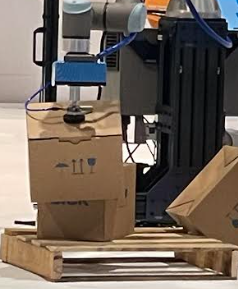Frontline Location: The Material Handling Institute’s ProMat 2023 Trade Show at Chicago’s McCormick Place Convention Center
Time of Engagement: March 20-24, 2023
By way of introduction, I am a “presales” consultant who assesses existing processes in warehouses and distribution centers throughout North America. My task is to determine the “best fit solution” for my sales executives to propose technologies that significantly improve the twin “holy grails” of process productivity and accuracy, using my company’s technologies. These technologies can be combined into “multimodal” solutions, which can be some combination of voice, scanning, vision, and robotics modalities appropriate to the specific warehouse or distribution center under consideration. These multimodal solutions are meant to enhance human workers’ speed and accuracy, and not replace humans with machines.
This role places me squarely in the frontline of technology adoption assessment needed to solve real world problems that underpin loss of competitiveness, profitability, and negative brand loyalty issues. This frontline is a very messy place to be, filled with confusion, misinformation, and limited visibility arising from the daily “fog of war” from the struggle to meet productivity goals.
Context and Background:
The Material Handling Institute or “MHI,” is arguably the premier trade association for companies serving many aspects of the global supply chain. Founded in 1945, it has been hosting an annual trade show, which has grown into the single most important venue for technology displays that offer potential future improvements for supply-chain processes.
Every even year (e.g., 2022), the show is held in Atlanta, and is called MODEX. In odd years (e.g., 2023), the much larger show is held in Chicago, at the McCormick Convention Center.
ProMat 2023 was the first “live” show since 2019 due to the impact of the COVID 19 pandemic. This year’s show had just slightly more than 1,000 exhibitors and about 56,000 attendees.
Compared to previous years’ shows, two particularly important observations can be made without any hesitation.
First, the attendees, mostly from companies that would “consume” the technology on display, displayed an eagerness to see what was new, releasing what I would call the “pent up demand” that four years of COVID’s suppression of live attendance created. What was also stunning was how many senior executives and owners were part of their companies’ teams stopping to assess exhibitors’ offerings. Most important, they brought to the discussions real world situations that they needed to solve, and the desire to move forward quickly to solve them.
Second, this was undoubtedly a robotics and intelligent sensors-dominated show. Both the North and South halls of the McCormick Center were “wall to wall” with companies that specialized in these technologies, as well as large, international systems integrators that were incorporating robotics and advance sensors into their customized solutions, mostly to the top-tier manufacturing companies in verticals such as CPG (consumer packaged goods), and large ecommerce retailers.
Supplementing this “wave” of robotics and intelligent sensor offerings were companies that specialized in command and control systems that tie together all of the components of an automated warehouse or distribution center. One such company, which was a surprise to me (as it was like a “fish out of water”) was Oceaneering, best known as the maker of undersea robotic devices. They were offering “supervisory software for mobile robot fleets.” The way I looked at it, they were providing their expertise in managing autonomous mobile robot units deployed throughout an automated warehouse.
Assessment of the Situation:
First, I saw almost no reference to augmented reality among the exhibitors. At ProMat 2019, this technology was the “hot button” for improving productivity for human workers, but in the four intervening years, a real use case that significantly improved worker productivity in activities such as picking for order fulfillment did not emerge. In my opinion, there may still be an opportunity such as product verification in quantity-control activities, but for the most part, it was a “flash in the pan.”
Talking with people who watched demonstrations of robots and their integrated intelligent sensors, there was the sense that as “cool” as robots were, they were still at a stage of development that offered limited use cases that could justify the cost of acquisition, deployment, and maintenance. The most significant observations centered on those twin holy grails: productivity and accuracy.
“Not Ready for Primetime” Issues:
It does not matter what products are handled in a warehouse or distribution center. What does matter at the end of every shift, day, week, month, quarter, and year, is that customers’ orders are fulfilled on time and with as high an accuracy rate as possible. The drive to improve on-time fill rates represents, in very real dollars, a gain or loss of business. The most important productivity enhancement technology that can be delivered today at an attractive price compared with robotics is that which increases the speed of human workers. Sure, we are all aware of the issues finding and keeping workers that companies face, but in today’s terms, humans are faster than robots in critical order fulfillment functions such as order picking.
This differential was apparent to every warehouse and distribution center operator I spoke with. If you took the time to stand and watch a robot order picking demonstration, while some “fixed-station” robots were somewhat speedy, mobile picking robots could not match the current speed of a human picker in most order fulfillment scenarios. I would liken their current operational speed to that of Mr. Pickles, our beloved land tortoise at the Houston Zoo.
Putting this in perspective, Mr. Pickles can move at about 0.16 miles per hour. A human can walk at an average speed of 2.8 miles per hour. An order picker in a typical warehouse, augmented with voice and scanning technologies and motorized pallet jacks, can pick 120 cases per hour, which equates to spending about 30 seconds at a location.
The other observation was that the mobile robots needed a human “minder” to control its actions. This was also apparent with fixed-position robots that, for example, transferred cases from one pallet to another. Even with embedded intelligent sensors that could “see” a case position and replicate that during case transfers from one pallet to the other, a human had to be standing by to remedy stacking errors.

Oops!
The emerging consensus was that augmenting humans with technology, compared to the current capabilities of robots, would continue to result in higher rates of productivity with higher accuracy with a much lower cost than replacing humans with robots.
This is like the classic “last mile” issue that cable companies faced when initially deploying fiber optics. The executives I spoke with estimated that it will take between three to five years to get mobile robotic order fulfillment productivity up to parity with current augmented human levels.
Attending ProMat this year was analogous to having an “over the horizon” radar capability, to see what technologies will potentially help companies operate more efficiently and profitably.

By: Tim Lindner


